














The new Carnage ™ III series rods are constructed from carbon or an e-glass and carbon blend, for an extremely powerful rod that leaves fsh begging. Yet it’s light enough to keep a fisherman going until the battle is won. Spec’d with high-end components like Fuji ® K-Guides, Sea-Guide ® and Fuji ® reel seats, plus a mix of hypalon/rubber shrink tube handles, the new Carnage III rod promises to be as ruthless as the name implies. PENN. LET THE BATTLE BEGIN ™ .
 ©2022 Pure Fishing, Inc.
©2022 Pure Fishing, Inc.

























Do you love boating? Then you know how fun and relaxing it can be on the open water. But you also know that things can go wrong sometimes, like storms, accidents, theft, or injuries. That’s why boat insurance is so important. Here are some reasons why.
• Boat insurance can help you pay for damage to your boat, or to other boats or docks, up to specifed limits.
• If you borrowed money to buy your boat, your lender may require insurance. And if you want to explore different places, some marinas or waterways may ask you to show proof of insurance.
• Boat insurance can also come in handy if you need an on-water tow, jump start, or fuel delivery with optional Sign & Glide® coverage. And if your boat sinks, boat insurance can pay for the cost of removing it from the water (if removal is legally required).
Get boat insurance from Progressive and enjoy the peace of mind that comes with it.
Scan to get a quote in as little as 4 minutes
Go to progressive.com to learn more.
If

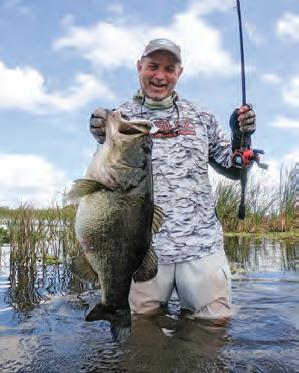


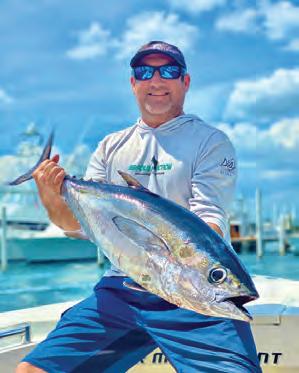


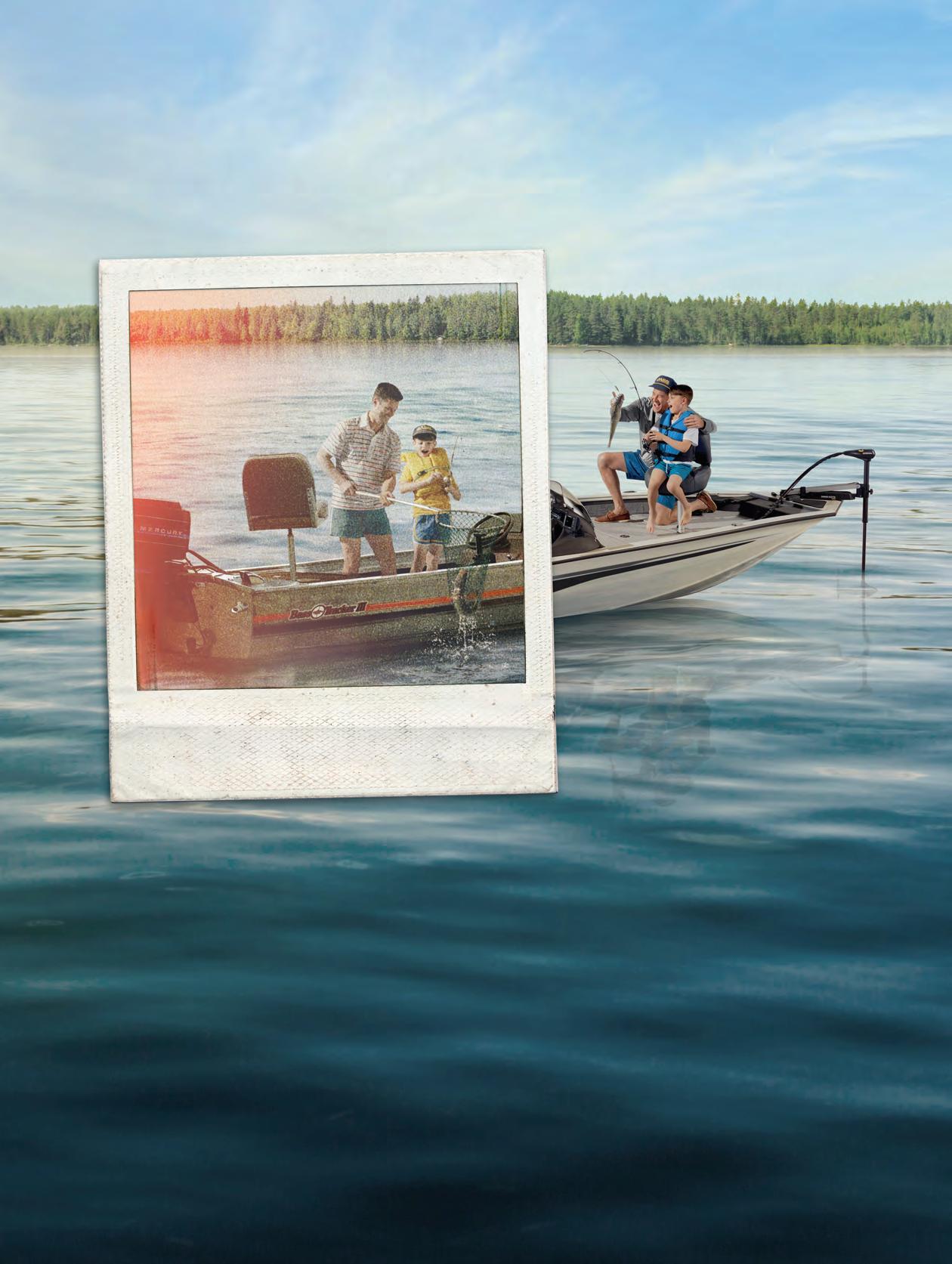



Introducing The All-New NavNet TZtouchXL Series
Transform Your Helm Into A Multi Function Masterpiece



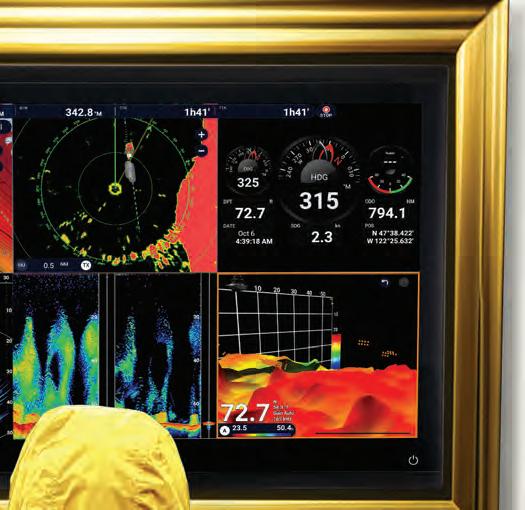

NavNet.com




Over the last few years, a burgeoning fshery has established the Gulf Stream out of Charleston as a big-time billfsh destination. Te ofshore trolling bite has been very good.
Capt. Mike Able keeps close tabs on the fshery. He and his brother, Graham, run Haddrell’s Point Tackle and Supply, a familyowned hunting and fshing store, which has grown to two locations and a fy shop in the Charleston area since their father, Mike Sr., started the business in 1983.


“Charleston has defnitely been put on the map with the billfshing we’ve had the last several years. It’s really been phenomenal,” Able said. “I mean, look at the Carolina Billfsh Classic. In the CBC last year there were outriggers full of sailfsh fags… we’re talking double-digit stuf. And not just the big boats. I mean, the big boats have an advantage, but guys are catching blue marlin from center consoles, too. You know the fsh are really chewing when the center-console guys are hitting fsh like that.”
Te Carolina Billfsh Classic (CBC) is one leg of the South Carolina Governor’s Cup Billfshing Series. It is held out of Mt. Pleasant each June. Last year, with poor weather
conditions during the one-day shootout, 47 boats released nine blue marlin and 53 sailfsh. Te top boat released four blue marlin. Te second-place boat released seven sailfsh and a blue marlin.
Able said conservation eforts, particularly from the Governor’s Cup, have led to healthier stocks. He also thinks anglers are getting better at fnding and catching billfsh. Te run outside the ledge is still 50 to 55 miles, but these days captains can go straight to potentially productive water. Satellite services make it easy to identify blue water, weed lines, temperature breaks and color changes to make a solid gameplan before leaving the docks. Additionally, technology like Omni Sonar can pinpoint fsh with an efective range of 5,000 feet.
“You could mark a fsh from a half mile away and go over and drop baits,” he said. “It doesn’t mean you can make them bite, but you know they’re in the area.”
Peak season for blue marlin and sailfsh is May and June, but blues will be in the area all summer. Sailfsh can be good into October or November, when wahoo enter the mix heavily. Able said a lot of marlin they catch are 150- to 200-pound “rats,” but they see some 300- to 400-pounders and an occasional 500-pluspound blue marlin. White marlin might also show up in a spread.
One of the perks of trolling out of Charleston in spring is you’ll also likely fll the box with dolphin and blackfin tuna. Capt. Able hung up his charter captain hat a few years back.
By Nick Carter
Now he fun-fshes with pretty remarkable success for billfsh and meat fsh by pulling a mixed spread with dredges, squid chains and circle-hooked ballyhoo from a ’34 Regulator.
Check out Haddrell’s Point Tackle & Supply at HadrellsPoint.com.


Instead of going “bottom fshing” this season, I would focus on going “grouper fshing”… at least for gags while the season lasts. You can go ‘bottom fshing” for the next seven months, but let’s put some gags in the boat while the law allows it! Here are some tips to help you bag some gags.
• Having the right bait is a major part of this puzzle. A pinfsh trap in a productive area for just a few hours and an (otter-proof) foating bait pen at the marina are priceless.
• You must anchor up or use the trolling motor in “spot lock” to properly fsh any piece of good bottom.
• When I frst post up on a good-looking mark on the recorder, I have everyone else on the boat fre down whole frozen squid on a jig. At the same time, I use a sabiki to catch whatever baitfsh are available on the structure. Here’s how it works:
1) Te squid might catch a handful “bottom fsh,” and maybe a grouper or two.
2) Most importantly, it sets a nice chum slick on the bottom that attracts the real predators of the structure directly under
your boat, and they will be ready to eat.
3) Afer four or fve volleys of squid, everyone baits up with a beautiful baseball-in-diameter-sized live bait and sends them back down to the bottom together. Tese baits are too big for most bottom fsh to get their mouths around.
4) Now, the grouper appear on the scene, curious about all the noise and the good smell. What do they see? Tey see a pinfsh from the marina or whatever came up on the sabiki. I like to fsh these baits on one of my Crab Decoy Jigs, which makes it look like the bait is struggling in the grasp of a hungry crab or squid. A big grouper, and especially a gag grouper, sees this as a Happy Meal. Tey love crabs, squid and baitfsh, and with this rig they think they’re getting it all in one bite.


5) An added bonus is that this is clean tackle, free of excess hardware, that sends the correct signal to grouper and results in bites.
• Te downside to this style of fshing is it will attract sharks. It’s all fun and games until the man in the gray suit shows up. Ten it becomes hard work. Sharks of all kinds are drawn to struggling snapper.
For more info on the jig, tackle and/or bait, check out Tim Barefoot’s YouTube channel and website at barefootcatsandtackle.com.





















 By Capt. Quinlyn Haddon
By Capt. Quinlyn Haddon
May 1 marks the reopening of Atlantic grouper season here in the Florida Keys. Over the past four months of season closure, a multitude of released catches taunted local fshermen, and now the hunt is ofcially back on!
While the Keys might not be well known for grouper, there is no reason why they shouldn’t be. Between the reef, wrecks and ofshore deep-dropping, the Keys are home to a plethora of grouper species. Te reopening of red, black, gag and snowy grouper vastly
increases fshing opportunities here in our Atlantic waters.
When fshing for grouper on the reef, keeping your rig from getting rockedup on the bottom is the biggest challenge. Do not overweight your rig, and keep an angler on or near the rod at all times. Grouper are notorious for grabbing a bait and taking it back into their homes immediately. When you lose a big grouper, especially with a mouthful of your tackle, they grunt a warning to the other fsh. Tis shuts down the grouper bite. It is best to keep the grouper rod in your hand when possible and be ready to crank them away from their hidey-holes. Tere isn’t much room or time for error on the initial bite.
Fishing for grouper over wrecks can also be highly productive. Amberjacks, which received a short closure in April, can be caught as bycatch while wreck fshing for grouper. Teir season also reopens in May.
Deep-dropping ofshore also expands greatly this month, as snowy grouper and blueline tilefsh reopen. Yellowedge grouper remains year-round, but even with large grouper hooks, tilefsh can be a frequent bycatch. Deep-drop rigs can be modifed this time of year to include smaller hooks that welcome the tilefsh bite and increase productivity of each drop.
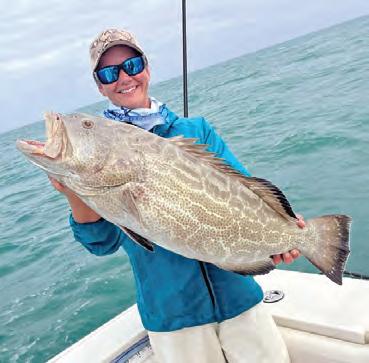
Te abundance of mahi-mahi this month sweetens the deal for heading shore to deep-drop. Not only can you fsh for mahi-mahi on the route to, from and on your deep-drop numbers, you can also chase birds for a chance to read the bottom for new deep-drop spots. Tere is nothing quite like fnding a new fshing spot, and with so much in season right now, it is the perfect time of year to scout.
Remember to check fshing regulations, as there are ofen surprise closures on many species. Venting and descending tools are required when fshing for grouper and are especially important at the depths where snowy grouper are found. One look at the bug-eyed balloon face of barotrauma will tell you these fsh cannot return home safely without help. It is easy to go over a limit of snowy grouper by accident, so have your gear ready and know how to use it.
Sweet E’nuf Charters specializes in grouper and is already booking up quickly for the much anticipated reopening. Give us a call to get tight!
Capt. Quinlyn Haddon guides with Sweet E’nuf Charters out of Marathon, Florida Keys. Contact her at (504) 920-6342 or Captainquinlyn.com.
Find her on social @captainquinlyn.



Julia Bernstein, 12, of Miami, had a record-setting day fshing of Key West on Jan. 5. She set two new state records in a day by catching a 20-pound, 15-ounce cobia and a 1-pound, 8-ounce mangrove snapper while fshing with Capt. Dale Bittner.

Bernstein’s records were the frst two fsh certifed in Florida’s new saltwater record categories, which were launched in January. Tey both set the bar in the new Youth All-Tackle Weight category. Florida is also now recognizing state records for Youth and Adult Length Categories.
“‘Are those all cobia?’ I couldn’t believe it, as we pulled up to the wreck, there was a dark cloud on the surface of the ocean. Sure enough, it was a large school of hungry cobia, and they were ready to eat!” Bernstein said. She quickly hooked up to two smaller fsh, but in her words, “Tird time was the charm; it was an even larger cobia! We had a great afernoon, we caught six fsh from that school, one of which became the Florida state record and one of which is a pending IGFA Junior Record.”
Bernstein already holds 11 IGFA world records.
To fnish the day, they made one last stop, where Bernstein hooked up with her record mango.
“I worked hard to get it of the bottom and then reeled as fast as I could. Good thing I did, turned out to be a state record mangrove snapper!” she said.
Joseph Ingold set the bar for the redfsh length state record with an impressive 36.25-inch red he caught from a Kayak in Panama City in February. His story is of a slow day that turned exciting in a hurry.
“About halfway down, I hadn’t gotten a single hit, so I cast my paddletail and let it sink to the bottom while I grabbed a new lure to tie on. Once I got my new lure ready, I started to reel in my paddletail to switch it out,” he said. “About fve seconds afer I started to reel it back in, the redfsh hit.”
Ingold thought he had snagged the bottom, but then the fsh began to run.
“I got super excited and loosened up my drag at that point. I really didn’t want to break her of since I was only using 10-pound test,” he said. “When I landed the fsh, I honestly didn’t even think about submitting it for the new length record. I actively participate in the Catch a Florida Memory programs, so I just took pictures for myself and for the Reel Big Fish program. Afer I submitted for a Reel Big Fish, I was curious if anyone had submitted for the new length record and, to my surprise, it was still vacant. So, I took all the pictures I had and put in my application.” CALL
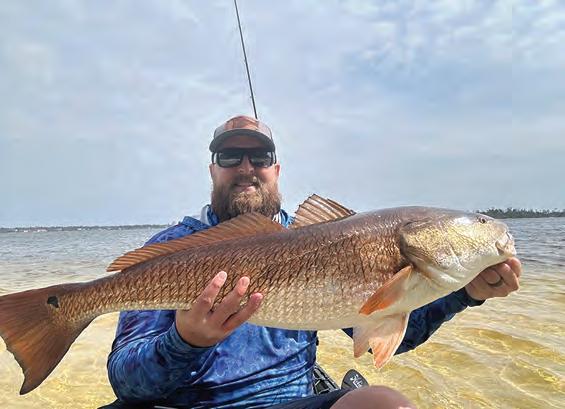
 By Mark Ambert
By Mark Ambert
You know spring has ofcially arrived when the eastern seaboard welcomes the arrival of voracious blackfn tuna! What better way to shake of the winter doldrums than to get out and target these small but mighty speedsters.
May and June are great months to target these fsh. Tey enjoy a wide range from Cape Cod to South Florida, and during the summer they migrate to temperate waters that remain above 70 degrees. Tey inhabit the warmest waters of all tuna species.
Blackfns are a schooling fsh and feed on migratory baitfsh, squid and shrimp. Tey frequently hunt the deeper side of the ledges and reefs common to the eastern seaboard. Tey commonly range from 5 to 20 pounds, with the occasional 30-pounder blowing up your bait!
Live bait is best for bigger tuna. I prefer goggle eyes, which can be caught or bought. Due to their hardiness, they are worth the cost to have on hand.
For live baiting, I use a Shimano Baitrunner OC size 6000 reel spooled with FINS 40G Braid. With the diameter of 6-pound mono, this braid has a tensile breaking strength of 45 pounds. I pair this reel with the Shimano Terez model TZS69M, 6-foot, 9-inch medium action spinning rod. I use a 6-foot section of Seaguar fuorocarbon in the 30-pound range for leader and Owner SSW 6/0 or 7/0 cutting point hooks. Blackfn are leader shy, so start with a 30-pound leader and move up to 40 only if you are experiencing breakofs.
I combine live bait with jigging techniques when targeting tuna. For high-speed retrieval of lures through the water column, which these fsh prefer, I use the Penn Battle III 4000 HS (high-speed) spinning reel. I pair this with a 6-foot, 6-inch Shimano Trevala B. I start of using Rapala Williamson Kensaki jigs in the 120- to 220-gram range.
Pro tip: Switch sizes and colors until you fnd what best “matches the hatch” rather than switching jigs.
I fsh early mornings, as tuna can be both light and boat shy. During a full moon cycle, the bite can turn of quickly as the fsh have been feeding most of the night. Once on my target area, I set up for a drif just outside the frst reef system, past the drop-of in deeper water to avoid bonito, sharks and kingfsh. Tis is typically in the 225- to 300-foot range. I deploy two live baits—one in the bow and the other in the stern—then jig in the middle. Check your fshfnder ofen to identify “scratches,” or fsh moving through, and mark the depth they appear in the water column. Target these fsh while jigging.
Te food quality of blackfn depends on proper bleeding when they are frst caught. Make a small incision behind the pectoral fn on both sides of the fsh to ensure the highest quality meat. Catching these speedsters will quickly become an addiction, and now is the time to make it happen!
Find Mark Ambert on Instagram @marksgonefshing_™; email: marksgonefshing25@gmail.com.











Whether considering repowering your trailer boat or your offshore beast, there is a Mastry Suzuki RePower Center that can serve your repower dreams. Mastry Suzuki RePower centers are the best in the business and have the experience, technical know-how and boating passion to make your repower project a remarkable success. With total boat systems capabilities your local Mastry Suzuki RePower Center can address all your upgrade aspirations. Essentially transforming your boat into a totally new boat at one single location.
With 15 Locations Across the Southeast There is a Mastry Suzuki RePower Center Near You.












*Get with the Program!



When you purchase a new Suzuki outboard from an authorized Mastry RePower Center you qualify to become a member of the Mastry Suzuki Owner’s Edge. Owners receive an identification card that provides them with important information about their Suzuki outboard motor as well as a passport to additional benefits during ownership. Members enjoy a detailed engine maintenance schedule, Mastry Suzuki RePower Trade Program and special pricing from Mastry Suzuki Partners.




Durable boat lifts expertly designed with Florida in mind.

ShoreStation hydraulic boat lifts are a reliable choice for coastal residents and boating enthusiasts alike. Their strong construction, made with corrosion-resistant materials, allows them to withstand harsh environmental conditions, including sun, storms, and saltwater damage. ShoreStation provides a steadfast solution for protecting waterfront investments, ofering peace of mind to owners in the Sunshine State.

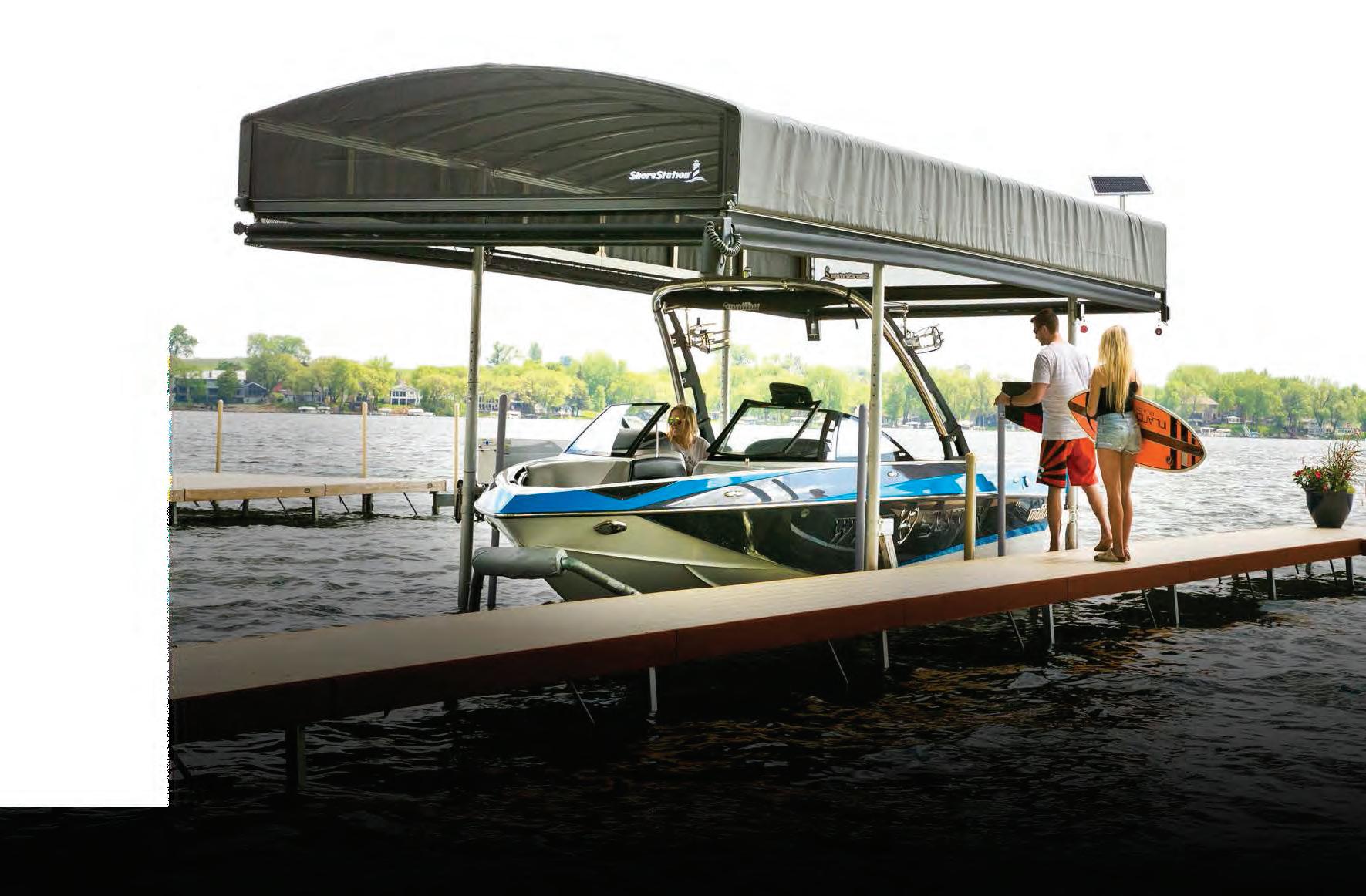




Equipped with exceptional weather resistant fabric and breathable SunTex 80 woven mesh ends for maximum protection and durability,

Made from the highest quality materials, our innovative hydraulic boat lift is one of the fastest and safest lifts on the market today. When you have a hydraulic lift, there’s no need to worry about wind and waves getting in your way. This lift will give you confdence to safely land and secure your boat in less-than-ideal conditions. No Piling Required

Never miss another moment on the water. Power your lift with clean, free solar power. Our speedy 20 watt charger features solar regulator drainage protection, saving your battery from permanent damage caused by overcharging.



Since early November, when the frst reports came in from the Florida Keys, scientists have been looking into reports of fsh exhibiting abnormal behavior referred to as “the spins.” Bonefsh & Tarpon Trust (BT&T) recently pointed its fnger at harmful algae as a likely reason for this phenomenon that has killed numerous endangered sawfsh and afected fsh of 30 diferent species.
Fish with the spins lose equilibrium and swim upside down in circles, ofen following a stressful or stimulating event. According to BT&T, a majority of reports for this behavior originated in the Lower Keys, between Big Pine Key and Sugarloaf Key, but there have been reports farther west toward Key West as well as in Miami north of Biscayne Bay National Park. Among the species afected are popular sport and food fsh such as tarpon, permit, snook, jack crevalle, mutton snapper, mangrove snapper, cubera snapper, goliath grouper and redfsh.
In January, BT&T and the Lower Keys Guides Association launched a study with the assistance of numerous other organizations to determine the cause of these events. BT&T stopped short of calling its results conclusive, because there’s still testing to be done, but they indicated occurrences of harmful algae blooms in the gambierdiscus family are the likely culprit.
Saltwater anglers will likely be familiar with ciguatera poisoning caused by the accumulation of ciguatoxin in predatory food fsh. Gambierdiscus is known to produce ciguatoxin and other neurotoxins that can have diferent efects on human and marine life. BT&T in not yet sure whether this variant of gambierdiscus is producing any cytotoxin that would move up the food web, but evidence indicates it is such a toxin that is afecting fsh.
Tese harmful algae are more common in reef areas that are environmentally stressed, according to BT&T. Testing continues and should hopefully provide more insight into this algae’s potential impact to the fsheries.
For more information, go to bonefshtarpontrust.org.






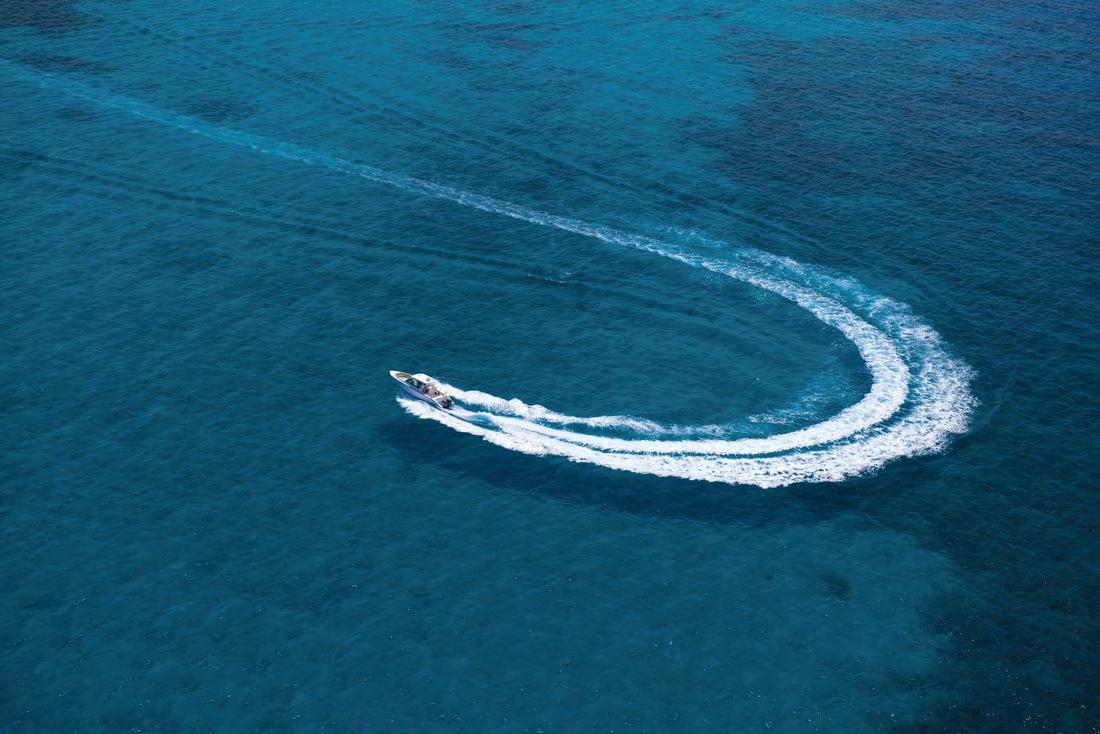

The 2024 Palm Beach International Boat Show (PBIBS), owned by the Marine Industries Association of Palm Beach County (MIAPBC) and produced by Informa Markets, marked a historic milestone in the show’s 42-year legacy, featuring $1.2 billion worth of vessels ranging from inflatables to superyachts, as well as the latest in marine accessories for consumers and guests to explore. This year’s show featured a record-breaking number of vessels on display, making it the largest edition in the show’s storied history.
Attendees were treated to an impressive lineup of global and U.S. debuts from key industry players, including Ocean Alexander, Fraser Yachts, Pursuits, Sirena, and Horizon. The introduction of a new engine and marine equipment pavilion provided boating enthusiasts and consumers with a selection of cutting-edge marine accessories and offerings.
“We maintain our focus on enhancing the overall guest experience,” stated Andrew Doole, President of U.S. Boat Shows with Informa Markets. “This includes dynamic activations like Nautical Ventures’ innovative in-water AquaZone presentation and a diverse array of educational seminars, including those by the Water Revolution Foundation highlighting sustainable boating options. Complemented by family-friendly activities and exclusive luxury VIP experiences for Windward VIP ticket holders, our goal remains to elevate every aspect of the event.”
For those seeking to elevate their show experience, the Windward Club offered an
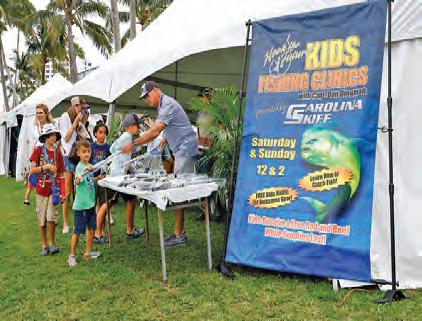


upscale retreat.
Nestled within the Lakeside Pavilion on Flagler Drive, this VIP enclave provided patrons with a space to relax, indulge in gourmet cuisine, and enjoy a premium open bar. VIP ticket holders also gained access to the Palm Beach Modern + Contemporary Art Fair (PBM+C). In collaboration with the fair, guests received complimentary admission to this esteemed art event. Presented by Art Miami, PBM+C offered an unparalleled art-buying experience, showcasing a diverse collection of artworks spanning various mediums and periods, including pieces by cutting-edge contemporary artists.
The allure of exclusive art seamlessly complemented the prestige of the featured yachts at this year’s event, making the Superyacht Show Palm Beach a must-visit destination for yacht enthusiasts. Located at Palm Harbor Marina, this extravagant showcase boasted superyachts epitomizing luxury and sophistication. With over 200 superyachts on display throughout the entire show, Superyacht Palm Beach offered a glimpse into the aspirational lifestyle of yachting.
Since 1982, the Palm Beach International Boat Show has anchored itself as a pillar not only for the Palm Beach community but also for the marine industry. The Palm Beach International Boat Show Gives Back program, funded through a portion of the show’s ticket sales, optional ticket price add-ons, and other boat show-related activities, supports projects that foster educational opportunities and enhance waterfront projects, positively impacting thousands of lives throughout the community.


Leading into the 2024 show, the Palm Beach International Boat Show Gives Back program proudly announced its contribution of $500,000 towards community enrichment initiatives.
“The Palm Beach International Boat Show is not only an economic powerhouse but also a cherished tradition within our community,” added Alyssa Freeman, Executive Director of MIAPBC. “Through initiatives like the Palm Beach International Boat Show Gives Back program, we reaffirm our commitment to enriching lives and fostering growth across the industry and throughout key community institutions that impact the everyday lives of West Palm Beach residents.”
“We are grateful for the support and enthusiasm that the West Palm Beach community, county and city officials, and residents show us year after year. It is the steadfast backing that fuels the success of the boat show making it a highlight for boating enthusiasts and industry professionals alike,” concluded Doole.
Mark your calendars for March 20-23, 2025 and join us for another unforgettable experience in beautiful West Palm Beach. For more information, visit www.PBBoatshow.com.
Daylight savings time is in full effect this month so be sure to take advantage of the extra sunlight we have in the late afternoons! We should have delightful springtime weather; winds will be blowing out of the E/SE the majority of the time. Offshore, when we have an easterly wind blowing for a few days, the pelagics will be pushed closer to shore. Trolling artificial and dead bait between 175-300’ will produce dolphin, bonito, blackfin tuna, and the occasional wahoo. Bonitos and blackfins show up again in our waters this month. When targeting blackfins, you can troll small feathers and squid pups. TIP: be sure to set your spread as far away from your boat as possible. Let the line out until you think it’s far enough and then let the line out some more! Blackfins are spooked easily by your boat, don’t run
Boca Raton, Lake Boca Raton, FL - May
www.youtube.com/DarcizzleOffshore with
Please be sure to check out my YouTube Channel “Darcizzle Offshore” for fishing videos every week!
towards the school on plane and slowly troll into the zone. Blackfins are known for feeding in lowlight conditions and love small live bait. Try chumming with cut sardines to bring these fish to your boat. A lot of cobia should be caught this month as well,
www.USHarbors.com
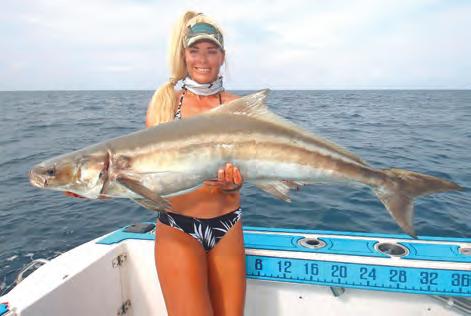
primarily in 90-150’ of water. Cobia will be hanging around the wrecks and following the sharks. Throw a chum bag out to bring hungry fish to your boat. Drift back dead sardines on a triple hook rig or a cobia jig. Remember, they need to be 36” minimum (fork length) in order to keep the fish. If you do get tight on a cobia using this method, reel as fast as possible to keep your catch away from the sharks. When fishing the deep-water wrecks, jigging will produce big amberjacks, African pompano, bonito, and mutton snapper. The bottom fish also love to eat live bait such as blue runners and goggle eyes.
Inshore, this is the month to catch yourself a big snook! This time of year, snook will invade the bridges and inlets and will eat just about anything thrown at them. At night, fish the bridges with flair hawk jigs, large swimbaits, or topwater lures. The live bait of choice this month will be mullet. Fish the bridges, inlets, and seawalls at first light or at night during the beginning of the outgoing tide or the last of the incoming tide. Tarpon will be showing up around the Palm Beach Inlet and mangrove areas feeding on crabs and shrimp. The best bait for targeting the silver king will be live shrimp, lip divers, and jerk bait.


• 42 passenger Coast Guard inspected vessel.
Buddy Banana Kibosh
By Keith Lozott Contributing Writerc apt. patrick Smith
• Air-conditioned salon with a 360 view of the outside.
www.swamptosea.com
• 561-503-0848
Typically, I don’t believe in superstitions, but a er a recent shing trip with my buddy Neil, I may be a believer!!! e morning started slow; I caught a small snapper and small snook. Neil was in skunk mode, so we decided to try a spoil island where I’ve caught some trout, snook, and a gag grouper on a prior trip. To our dismay it was dead as well. Just as we were about to exit stage le , Neil was working a topwater lure back to the boat when what appeared to be a large bull shark came up from the bottom and tried to hammer the lure. Unbelievably it totally missed the lure and disappeared. It was impressive to witness such a big specimen of a sh take a swipe at the lure.

Big peacocks were turned on for Nicole’s day on the lake.

This big snook couldn’t resist an X- Rap fished along a rock pile.
By Keith Lozott Contributing WriterA er the “Shark Week” experience, we continued to struggle so I decided to implement Plan C and move from the east side of the Indian River to the west side. I’ve had some nice shing on the west side with trout, reds, and snook. We made our way across the river stopping at another spoil island only to be greeted with a jack attack. I landed several jacks and Neil hooked one that got o . His skunk was still intact but with jacks around I gured that would change. Unfortunately, that wasn’t the case.
Typically, I don’t believe in superstitions, but a er a recent shing trip with my buddy Neil, I may be a believer!!! e morning started slow; I caught a small snapper and small snook. Neil was in skunk mode, so we decided to try a spoil island where I’ve caught some trout, snook, and a gag grouper on a prior trip. To our dismay it was dead as well. Just as we were about to exit stage le , Neil was working a topwater lure back to the boat when what appeared to be a large bull shark came up from the bottom and tried to hammer the lure. Unbelievably it totally missed the lure and disappeared. It was impressive to witness such a big specimen of a sh take a swipe at the lure.

A er the “Shark Week” experience, we continued to struggle so I decided to implement Plan C and move from the east side of the Indian River to the west side. I’ve had some nice shing on the west side with trout, reds, and snook. We made our way across the river stopping at another spoil island only to be greeted with a jack attack. I landed several jacks and Neil hooked one that got o . His skunk was still intact but with jacks around I gured that would change. Unfortunately, that wasn’t the case.

• Low profile and extremely wide 20 foot beam for a smooth and stable ride.
Eric found a nice juvenile goliath and managed to get it out of the structure.
We used the trolling motor to quietly make our way towards the mangroves hoping to get a glimpse of a red, snook, trout, ounder, or any inshore species willing to bite. As we approached the shore, we noticed another bull shark working the shore and of course I had to make a cast or two at him, but he had no interest in my o ering. We kept working the shore and nally it happened for Neil!!! He made a long cast and almost as soon as the lure hit the water, he was on with a nice sh, but we couldn’t see what it was. He started gaining ground getting it closer; enjoying the ght and then it happened! e sh came unbuttoned and at this point I was like dude, what did you do in a previous life to deserve this??? We made our way toward a dock that I know holds snook. I made a long cast and right then I was hooked up with a huge sh. It was a big snook; I got her to the boat, revived her, and released her to ght another day.
Burt and Burt Jr. released an awesome lagoon blacktip shark.
$55 - Seniors (Over 65, Weekdays Only)
ay is here and it’s time to start the summer program, which means more offshore action for those of us that have smaller boats. Unlike spring, where there are more windy days than calm days, by mid-May, it should make a switch and do just the opposite. On those calmer days there should be plenty of action to take advantage of. Early morning, I head straight out offshore looking for weed lines and mahi. There should be plenty around but pay attention to the amount you take, and the sizes of the fish last year. Most of them are not legal but still lots of fun on fly and light tackle. Once you
We used the trolling motor to quietly make our way towards the mangroves hoping to get a glimpse of a red, snook, trout, ounder, or any inshore species willing to bite. As we approached the shore, we noticed another bull shark working the shore and of course I had to make a cast or two at him, but he had no interest in my o ering. We kept working the shore and nally it happened for Neil!!! He made a long cast and almost as soon as the lure hit the water, he was on with a nice sh, but we couldn’t see what it was. He started gaining ground getting it closer; enjoying the ght and then it happened! e sh came unbuttoned and at this point I was like dude, what did you do in a previous life to deserve this??? We made our way toward a dock that I know holds snook. I made a long cast and right then I was hooked up with a huge sh. It was a big snook; I got her to the boat, revived her, and released her to ght another day.
get your fill of that, you can head to the ledge and look for bonita, kingfish, and even wahoo. These are all great light tackle fish and live bait, lures, or flies will work. If you’re able to net small bait in the morning, throwing a few handfuls out for live chum in the summer is a sure way to get a lot
of action. Be careful not to overdo it though, as it will attract a lot more than the usual number of sharks. On the way in, this is a great time to check the beach and the inlet for both snook and tarpon, especially if you have some extra live bait left. The freshwater bite will be crazy as the peacocks will have spawned a couple times already and they will be nice and warm and ready to eat. There will be tons of bait as the spawn in March seemed to be very successful for the threadfin shad. If you’re going to fish artificial, I would suggest matching the hatch with chrome rattle traps, or a silver unweighted fluke. There will still be plenty of clown knifefish action and even some big largemouths. Good luck out there!
Success! I said, “let’s go to lunch and call it a day”. I asked Neil if he was hungry and then he disclosed to me that he ate a banana for breakfast! Neil knows not to bring bananas on the boat (it’s bad luck), but it didn’t occur to him that the curse would remain in e ect with it digesting in his stomach. Myth con rmed or was it bad luck? He should’ve brought his lucky rabbit foot!!!
Keith Lozott The Fishing RealtorSuccess! I said, “let’s go to lunch and call it a day”. I asked Neil if he was hungry and then he disclosed to me that he ate a banana for breakfast! Neil knows not to bring bananas on the boat (it’s bad luck), but it didn’t occur to him that the curse would remain in e ect with it digesting in his stomach. Myth con rmed or was it bad luck? He should’ve brought his lucky rabbit foot!!!
• The closest drift boat to the Boynton Beach Inlet so there’s more time to fish!

tuesday special 1:00pm-7:00pm (6-hours)
$80.00 per person
give us a try and see what everybody is raving about! We put the “FUN” back into drift boat fishing! so sit back, relax you’re on island time!
fish tripsBoth tuesdayoN
$130 per person
10-trip special $500 Best$100.00saViNGs off
PRIVATE CHARTERS AVAILABLE FOR CORPORATE GROUPS, FAMILY PARTIES & MORE!
$55 - Active Teachers, Military, Law Enforcement
Join Us & Catch:
King Mackerel • Wahoo
Dolphin • Snapper (all kinds)
Sailfish • Grouper
Bonito • Cobia

Sailing two trips daily, 7 – days a week! 8am – Noon • 1pm - 5pm (Tuesdays 1-7pm)
Night trips – Wednesday & Friday 6pm – 10pm seasonally – call for more info. Plenty of free PArking very close to the boAt!
Sailing two trips daily, 7-days a week! 8am-Noon • 1pm-5pm (Tuesdays 1-7pm)
$45 - Children 12 & under
All licensing, bait & tackle included. + gratuity for crew

$50 VIP Program
Keith Lozott The Fishing Realtor







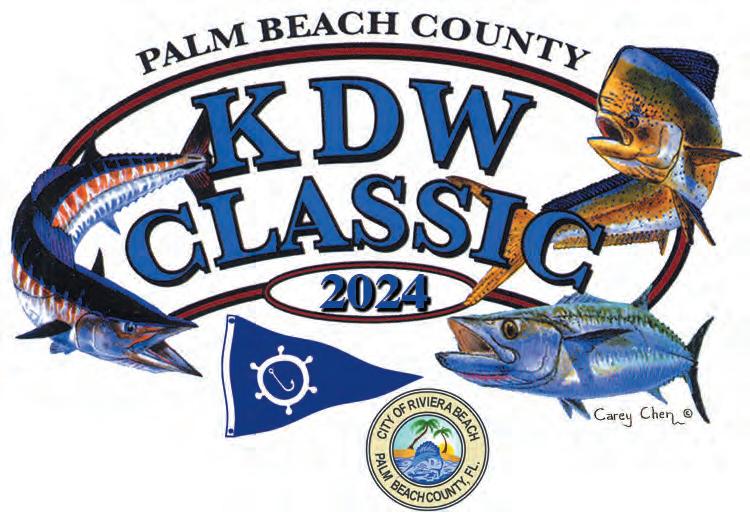

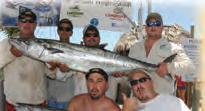








LrdRiverCenter.org/austinblu LrdRiverCenter.org/austinblu


his is the time of year boat shows return to the local areas and what a great way to find some new and effective products to meet your boating activities. While attending the recent Miami International Boat Show I was amazed at all the new and innovative products offered. One product caught my attention, the T-Top Boat Shade by LaPorte Products. My wife and I have been looking for a boat shade, but at a reasonable price point. Custom options were expensive and more than what we felt we needed. I was so glad when my wife said “look over there” as we were winding down and getting ready to leave the convention center. A large display showcasing fore and aft sunshades! We were mostly interested in the aft shade and quickly engaged a sales rep who was extremely knowledgeable and helpful. He quickly helped us navigate options and determining the correct size and fit for our boat – a 31’ Prowler Catamaran style center console. Turns out our boat worked with the standard boat shade kit. I was encouraged by the design and attachment options as I hoped to be able to leave it up for fishing during the brutal summer days. I was assured the material could withstand in excess of 35mph when underway and would not have to be taken down. My wife and family wanted shade for Sunday sandbar excursions and in particular – the lounging area in the cockpit. The LaPorte sunshade looked like it would fit the bill for both activities.
The resilient fabric has an outer UV reflective coating which provides UV-protection in marine environments. The UV reflective coating offers an effective UV block of 98% and it will reflect up to 75% of UV heat. The material allows the shade a 20% stretch to fit many size boats while still creating a custom fit
appearance. The shade can handle speeds up to 30 knots while staying whisper quiet. It comes in two colors – white and black and I opted for black. The workmanship of the display item seemed appropriate to my needs and at a good price point. I was sold and purchased one to be shipped direct from the manufacturer.
Once it arrived, I couldn’t wait to install. The instructions were excellent and although the initial fit is more time consuming, I had it installed and adjusted for proper fit in about a half hour. Everything needed was in the bag and once fitted, taking it on and off and stowing it was a breeze. It takes up hardly any room once stowed in the bag. The manufacturer recommends not to leave it permanently installed and anyone living in Florida can attest to why – the sun exposure here is brutal on most things boating. The product comes with a oneyear warranty.
As luck would have it my youngest son was in town for the weekend, and we spent a day at one of the local sandbars. The sunshade was much appreciated and worked like a charm. I have yet to use it fishing but once installed it seems doable and easy to navigate the cockpit with the sunshade deployed.
If you are looking for something similar –look no further. I can highly recommend this product based on fit, finish, ease of installation and quality of materials and at a very attractive price point.
mark
ambert, iG @marksgonefishing_™ marksgonefishing25@gmail.com_laporte products
https://laporteproducts.com/





























• 561-635-6899
• www.aquaadventuretours.com

IMasters of updrafts, these birds spend most of their days gliding through the air and rarely even need to flap their wings. Part of the raptor family, they’ll hunt and eat insects and small fish on the fly. For larger prey like frogs, snakes, or even small mammals, they often take their catch to the tops of trees to feed.
Swallow-tailed kites often fly and feed in pairs so if you see one, look around and try to find its mate. They’ll often perch next to each other on branches 20-30 feet
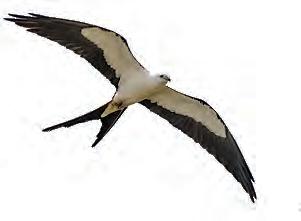
f you enjoy learning about Florida’s varied ecosystems, there’s a great way to do so year-round through bird watching. Although it takes time to acclimate to our summer heat, particularly inshore, one of my favorite inhabitants of freshwater marshes this time of year are swallowtailed kites.
We occasionally see these birds along our coastal waters, but you’re much more likely to see them zooming through inland cypress and pine forested wetlands, similar to those you’ll find at Grassy Waters Preserve, Loxahatchee Slough, and Winding Waters Natural Areas.
With wingspans of about 4 feet and a very pronounced v-shaped tail, swallow-tailed kites can out-compete just about any other bird out there in terms of acrobatic moves.
www.USHarbors.com
Jupiter Inlet, south jetty, FL - May 2024

These birds’ winter in South America and migrate to the US in March/April to nest and raise their young. They’re usually here in South Florida until August/September before heading south once again in late summer. Once very common throughout much of the eastern US and as far north as Minnesota, unfortunately, plumage hunting and habitat losses over many decades reduced their North American range to just the southern US.
But things may be on the upswing - sightings throughout the last 10 years or so suggest they may be slowly re-establishing their historic ranges. Several projects are underway to help determine where these birds are spotted and how often.
One such project is right here in Florida. Several birds who summer here have been tagged with trackers that enable researchers to learn more about the lives of individual birds.
Check out https://www.arcinst.org/blog/ to learn more about Palm Beach County’s very own Lox 22, Lucky Lox, Juno, and Cypress! Keep an eye out for them if you find yourself exploring our inland natural areas this month.
Hope to see you on the water!





Welcome to the May fishing report. Anglers that like variety will love the month of May.
Off the shores of Palm Beach, the spring kings will be plentiful. The waters south of the Breakers Hotel or north of the condominiums will produce some tournament winning fish. Try slow trolling a live blue runner or a goggle eye in depths of 80 to 120 feet. Don’t forget to put a stinger hook in its tail! Also, in May the blackfin tuna bite will be on. These fish are hard fighters and make for great table fare. For blackfin, you will need a 20 lb. spinning or conventional gear combined with a light fluorocarbon leader and a small hook. A good tactic for catching tuna is
live chumming off the edge of the Gulf Stream. Try depths from 150 to 300 feet and get the bait down deep. Remember that tuna are low light predators, so early morning or late evening will be the best bet.
The reef bite will be good this time of the year. The sun sets later than in the winter, so take advantage of this extra fishing time. You may be rewarded with a nice mutton snapper or flag yellowtail.
For you inshore anglers, look to the beaches. Tarpon will be running in packs of six to ten. Cruise the beaches and look for any black patches that move. These fish will be chasing sardines. Try pitching a live sardine or jumbo shrimp in front of the school and hold on! Remember to point your rod at the fish when it is jumping.
Let’s now talk about the sword bite. Calm seas will allow you to head 20 miles out to the humps of Palm Beach. The new bait of choice is the squid tentacles that seem to be able to drop without


spinning and give you a better presentation. Fishing two rods will give you better odds. If you’ve never fished two rods before when swordfishing, check out our YouTube channel on how to @ reelintensefishing, where we give you a nice demonstration of how to bring the odds up with two rods.


Happy Mother’s Day! May offers great fishing for the Jupiter and Palm Beach area. Local waters are teeming with a plethora of species and anglers can expect plenty of rod bending action.
Snook fishing heats up as they start to migrate to local passes and beaches for their upcoming spawn. The snook can be seen cruising near seawalls and docks in search of food. Live baits and D.O.A. C.A.L. 3” Shad Tail on a 1/8-ounce jig head casted in their vicinity will get your drag screaming. Bait schools will be in our local area, and this is the time for topwater action. Rapala Skitter Walks worked over open flats and near heavy structure will cause some explosive action. If you have never experienced topwater action for snook, I recommend you try, there is nothing like it. These snook will range in size from 5 to 20 pounds.
Tarpon aka the “silver king” are a great target for anglers looking for explosive strikes and acrobatic jumps. Tarpon can be found in the ICW, local inlets, and beaches. Live baits like mullet or pinfish work great. Artificial baits like the D.O.A. TerrorEyz and D.O.A. C.A.L. 3” Shad Tail in pearl and melon/ back will get the drag screaming.
The inshore waters will also be teeming with jacks, sharks, ladyfish, snapper, and many other species that will put a bend in the rod. Live bait freelined with the tide or a Rapala X-Rap will get the strike.
Well, that is the fishing forecast for May. I hope everybody enjoyed, now get out there and experience the thrill of drag screaming action. Tight lines!





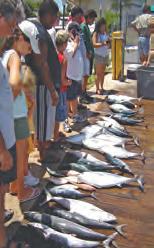

The sportfishing in May is spectacular! We’ll be catching some of the biggest and best fish during this month. Dolphin (mahi-mahi) will be biting strong on the inside edge of the Gulfstream in only 300400’ of water and eating just about anything you throw at them. Trolling works well for mahi-mahi, wahoo, and tuna, but slow trolling live ballyhoo from the outriggers or kite fishing using goggle eyes are the best techniques to get the biggest dolphin to



along with some grouper and cobia; and you can finally keep groupers again as they are in-season as of May 1. There is quick action on big fish to be found fishing around our local shipwrecks. Big
bite. A few sailfish will be still biting and if you really feel lucky, a rare marlin can be seen offshore. Night swordfishing will also be getting good when the weather cooperates, as May is an overall great month for billfish.
Amberjacks are abundant on the shallow and deep-water wrecks,
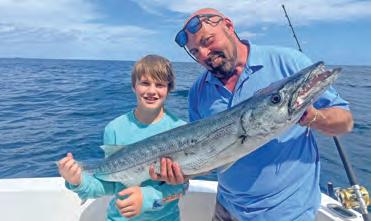

game sharks will also still be pouring through as hammerheads, mako sharks, threshers, and big bulls are doing their annual migration through our waters. If you want to hook into and catch one of these monster game fish, now is the best time. Sharks go where the action is and there is plenty of action happening in Fort Lauderdale this month. Tight lines all!

May offers consistency in our weather, which leads to incredible fishing. Both the Lake Ida Chain and the Everglades have been fishing well. The Everglades water level hasn’t come down much with the extra rain we have gotten. When the water level is high, it allows those fish to go and hide in usually dry areas. On the Lake Ida Chain, water levels have been fluctuating so much that it’s been tough to find a consistent bite, you have to move around a lot more to find those fish.

The Lake Ida Chain is known for big fish this time of the year and for big numbers. It’s not uncommon to see 100 fish days on the lake. The main bait of choice is live shiners. There’s so much fishing pressure, it’s imperative to have some fresh live bait on hand for those picky eaters. I personally love catching them on the fly rod using artificial lures like top water spooks and jerk baits. I have been in love with the Shimano Zumverno 95 lately. In my opinion, it’s the most effective jerk bait in my arsenal. The Zumverno 95 is perfectly neutrally, buoyant, and offers a feature like no other lure on the market, Flashboost. When the lure stops moving, there’s a shimmering piece of metal that continues to move inside, making it look like a real live bait. I’ve had great success with this one everywhere in South Florida.
Everglades fishing, with the water level high, we’ve seen more peacock bass and fewer cichlids such as oscars and mayans. The bluegill population has increased dramatically this year, which is exciting for me because they are very aggressive, competing against the exotics, making them a blast to catch on the fly and artificial. I love throwing the Z-Man Micro Finesse lures for them simply due to their durability.
I’m looking forward to an outstanding year of fishing this spring with hopefully low water and lots of peacocks.
Topwater for snakeheads is one of my favorite things to do. American Snakehead Customs lures have made the game easy with their signature “Snek Frog.” Overcast and rainy days are the best for throwing topwater at these swimming dragons. It’s 100% legal to release a snakehead back into the same body of water where you catch it. If you prefer to un-alive them, they make great table fare. Snakeheads, or “sneks,” as many like to call them, are some of the hardest-fighting fish in freshwater. You can find them mainly from Wellington to Hollywood and everywhere in between. Look for the smallest canals possible that have lots of cover. Their eyes are on the top of their head, so they often hide under trees and overhanging banks to protect their eyes from the sun. Most good snakehead spots are small community ponds that don’t get a lot of fishing pressure.
There are lots of fishing opportunities out there this month. Go explore some new spots and have fun!



Spring is heating up as we march towards summer, and so is offshore fishing! We can expect excellent swordfish and mutton snapper fishing throughout the season with some mahi-mahi mixed in. The unpredictable fishing weather we experienced this spring so far continues to put less pressure on our recreational swordfish fishery by offering limited days to capitalize on this red-hot bite. I had the opportunity to take advantage of the springtime push with three trips, each doubling up on swordfish weighing over 150 lbs. On the fourth trip, we managed to reel in an absolute sea monster, but lost it after a three-hour fight! On this same trip, we helped my new friends catch their first-ever swordfish on the buoy. It’s very rare, yet not unheard of to catch giant bigeye tuna and bluefin tuna on the sword grounds, and we suspect that’s what we lost on this last trip. Judging by how this fish was fighting and peeling drag off the LP with over 25 lbs. of drag applied. There are no boundaries in the ocean; each trip holds the possibility of catching that next once-in-a-lifetime fish. We have little control over what happens out there, so it’s best to control what you can and use the best gear possible to be prepared for that fish of a lifetime with the Gulfstream Custom Rod Company as your trusted outfitter.








• Great Customer Service
• Unlimited Range Time
• Florida Concealed Weapons Classes
• FiReaRmS TRaininG CouRSeS
Beginner to advanced & Private Classes
Provided by Florida Firearms Training
• Fully air Conditioned Range
• maintained at 72 Degrees





with
772-201-5899
c apt. B rian nelli
• Brian@tckayakfishing.com
• tckayakfishing.com
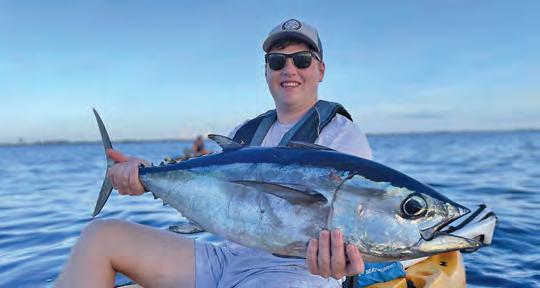
May is finally here! Snook will be back as the main target inshore this month. Fishing seawalls, bridges, and docks are your best bet. Beef up your tackle a bit to be able to pull these fish from structure. I like using a Crowder Rods 7’ 12-25lb. E-Series. Teaming that up with a live mullet and circle hook on 60lb. fluorocarbon leader. For artificial, a Yo-Zuri Lures TopKnock or D.O.A. Bait Buster are great options.
May really kicks off the best time to fish offshore. Weather, numbers of pelagics, and bait should make this month enjoyable. Mahi, tuna, sailfish, wahoo, and kingfish will all be in the normal trolling waters of 60-250 feet of water. I really like to focus on the tuna using a vertical jig. A Catch Fishing jig dropped in 200-300 feet of water can be deadly on these fish. Look to focus on getting your jig to the mid-water column and mix in a variety of different speed retrieves. If you want to use live bait goggle eyes, pilchards, threadfins, blue runners, and mullet will all be good presentations. Deep diving Yo-Zuri Crystal Minnows are a great option as well for an artificial presentation.
Freshwater
Peacock bass and clown knifefish will be chewing this month. Prop baits will work well for peacocks along shallow edges. Try 15lb. Yo-Zuri fluorocarbon leader and a 2/0 circle hook casting in and around structure and weed lines to get onto a few clowns on shiners. Look to fish the mid-water column and below by adding a pinch weight to your leader and get that bait in their face.
Check out Pushin’ Water Kayak Charters on Facebook, Instagram, and TikTok for all the latest adventures my clients and I get into.

The month of May heats up with great fishing! The fish are very active, and the bait is running throughout the creeks, canals, rivers, and lakes of the Everglades National Park, as well as the freshwater areas of the Glades. On our most recent trips we’ve experienced some very active tarpon, snook, redfish, and peacock bass; they are all being caught in large numbers.
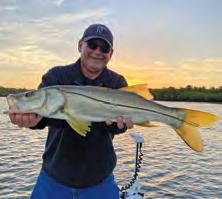

On one recent trip (pictured), we headed to the rivers and backwaters of Flamingo with Alex from West Virginia, who was eager to catch his first big tarpon and some snook. We met up at the ramp at 6A in the dark and took off through the Buttonwood Canal, traveling a total of 80 miles and hitting about 16 prime spots. Alex had caught record numbers of large fish but had yet to experience the silver king. He was so impressed with the raw power of the tarpon how it got airborne at least 4 times during the 12-minute fight. This fight was not just exciting but impressive, while in heavy current and some winds, and lifting the trolling motor and engine up so the line didn’t catch. Then, being blown to shore and putting the engine down to move while the fight just kept going until the exhausted Alex and the silver king came to a rest.
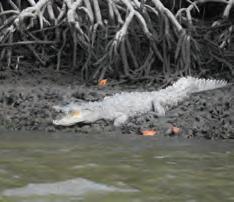

I was not sure who was going to win this battle, but Alex ended up prevailing and the pictures show the winner here. Alex landed a 90lb. plus tarpon and 12 snook, each over 25 inches. Next on his bucket list is a goliath grouper when he returns for another adventure. Alex was intrigued by the beauty and the nature of Flamingo as we encountered sharks, manatees, crocodiles, and porpoise along the way.

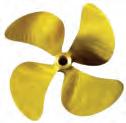

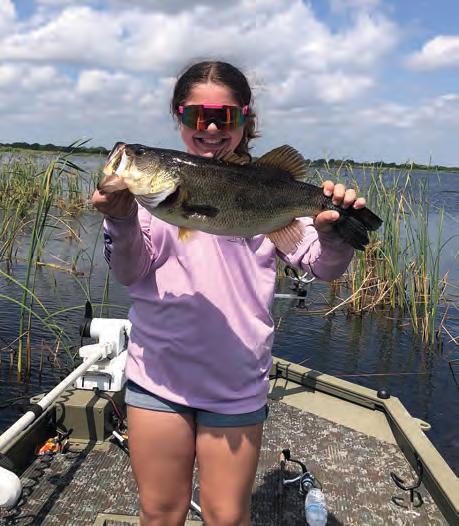





Bragging is good!
Send us your catch photos with details: Who, When, Where, With What, etc. to ilene@CoastalAnglerMagazine.com
Brandon Abhau reeled in this nice peacock bass using a rattle trap from a Royal Palm Beach canal. Lianna Davis caught a beautiful bass on the north end of Lake Okeechobee. Jackson and Jeremy with twin yellowfin tunas in Costa Rica. Orion was visiting from Mt. Dora and caught this Spanish mackerel from the Jupiter Inlet with a little help from his grandfather Ronald Storm. Jeffrey landed his first Pacific sailfish of over 100 lbs. while in Costa Rica.
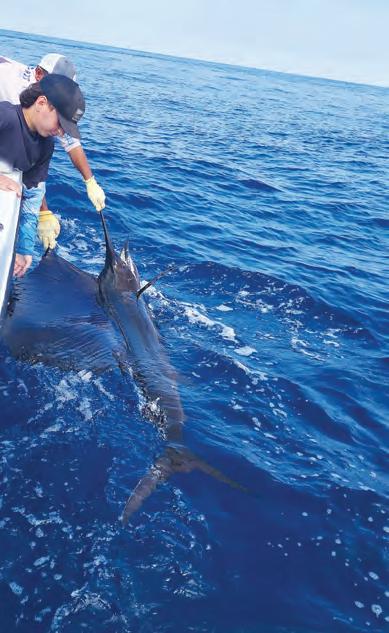



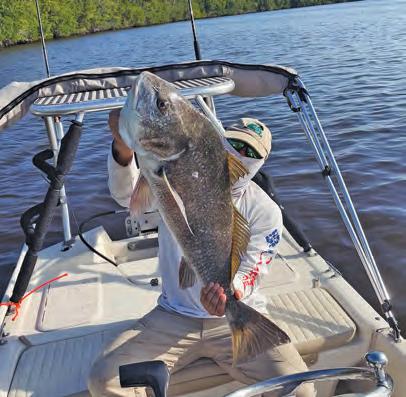

Bragging is good!
Send us your catch photos with details: Who, When, Where, With What, etc. to ilene@CoastalAnglerMagazine.com
Electric Dave caught & released this big sailfish while kite fishing in 125 feet of water on a live threadfin herring. Brixton Harvey caught this beautiful peacock bass on his own in Pompano Beach. Jackson in Costa Rica posing with his first Pacific sailfish after a few great tail walks. Jed Larsen caught this barracuda in Jupiter with Captain Jeremy Neff of Go Fish Stuart. Chris had an awesome day of dolphin fishing off Pompano Beach. Marcos Arroyo from West Palm Beach had a 20-minute fight and then released this trophy black drum in Everglades National Park.

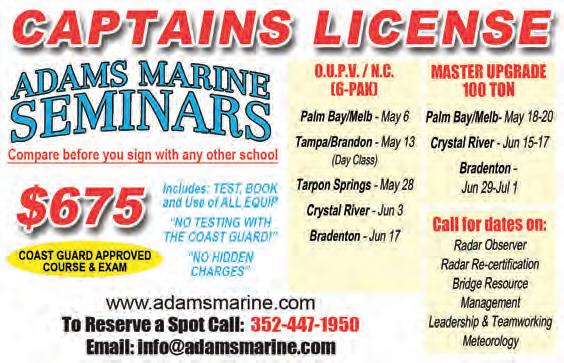









Pasco County scallopers will get a 40-day season in 2024 afer the Florida Fish and Wildlife Conservation Commission approved a change to the management region during a February meeting. Te season for the Pasco County Zone will begin July 10 and run through Aug. 18, annually.
Tese long-term season dates were informed by the 2023 post-season monitoring results by FWC’s Fish and Wildlife Research Institute as well as input received from stakeholders at virtual public workshops, in-person meetings and public comments.
“Along with moving away from the Independence Day holiday, the longer season will increase both the public’s safety and access to one of our state’s most fun family resources,” said FWC Commissioner Preston Farrier. “ Tere will be many positive impacts for the local communities.”
Te Pasco Zone bay scallop region includes all state waters between the Hernando/Pasco county line and the Anclote Key Lighthouse in northern Pinellas County, and includes all waters of the Anclote River. For complete regulations, visit MyFWC.com/Scallops.












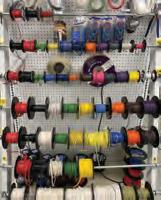
























 By A. deGruchy
By A. deGruchy
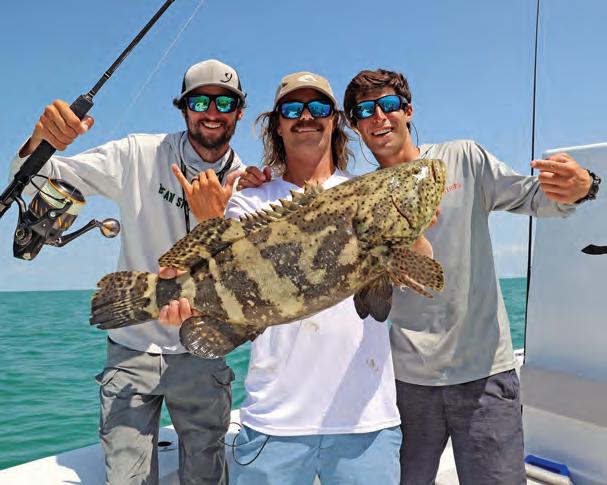
You’ll fnd some real giants lurking in Florida waters, ofen hanging out near wrecks, structures and mangrove roots. Te notorious Goliath grouper is a massive, territorial and iconic Florida fsh that has experienced a remarkable comeback in recent years, prompting the Fish and Wildlife Conservation Commission (FWC) to introduce a lottery system for limited harvest.
It’s been quite the journey for these giants of the sea. Back in the 1990s, they were critically endangered, and conservation eforts swung into action


to protect them. Trough the 2000s, Goliath grouper started reappearing in South Florida’s coastal waters in greater numbers. Some saw this as a positive thing, while others focused on the negative potential impact on the marine ecosystem.
With their enormous size, reaching lengths of over 8 feet and weighing up to 800 pounds, these beasts could easily throw of the delicate balance of fsh populations and reef habitats. Despite the initial concerns, strict conservation measures and protective regulations led to a remarkable population rebound. Tey once again rule as apex predators; some would even call them bullies!
We were lucky to receive one of the tags to harvest a Goliath this year. Tere were specifc protocols to follow. Te FWC divided it into Category I and Category II, restricting the fshing areas. Additionally, there was a stipulation to use non-ofset, non-stainless steel hooks to improve survival chances. Tere was also a research element involved. We were issued a kit for taking samples and instructions on where to drop of the carcass afer our fsh was cleaned.
Goliath grouper have big appetites, eating large quantities of food to sustain their massive size. Tese underwater monsters can consume up to 5 percent of their body weight in a single feeding, so an average adult weighing around 400 pounds might eat 20 pounds. Tat’s a hefy meal by any standard. Tey also eat pretty much anything that moves, and they love crustaceans, especially stone crabs.
With our tag, we managed to catch one that fell within the slot size of 24 to 36 inches set by the lottery. We gave it a try, and to our surprise, it tasted great, like a meatier version of traditional grouper: white, faky and juicy, probably due to their diet.
Goliaths are a lesson in how tricky the balance can be between preserving our marine life and using it responsibly. From nearly disappearing to bouncing back in a big way, these amazing creatures keep us hooked on their journey. Tey remind us how everything in the ocean is connected and how important balance is. Whether we’re rallying to protect them or frying them up for dinner, Goliath grouper are a signifcant part of what makes Florida’s marine ecosystem so unique.
To see the episode of our Goliath Grouper Catch & Cook, go to “Bean Sportfshing TV” on YouTube. For more information about FWC’s Goliath Grouper harvest program, visit: www.myfwc.com.






 By Emily Hanzlik
By Emily Hanzlik

Amberjacks are powerful fsh with a never-quit attitude that makes them prized among anglers who live for the battle. Tey are a widespread species, with a pretty much worldwide range and prefer depths from 60 to 250 feet. Typically, they live near reefs and shipwrecks in small schools. Tis is due to their diet being mostly smaller fsh, crustaceans and squid that live around these structures.
An amberjack might live its whole life around these structures and only move due to lack of prey or for spawning. Amberjacks broadcast spawn, but usually in smaller groups. A single female can produce anywhere between 20 and 50 million eggs. Afer spawning, these fsh participate in some sort of courting and will stay in pairs. Adults can weigh up to 200 pounds and grow to 6 feet in length with a lifespan of more than 15 years. Most angler encounters are with fsh up into the 40-pound range.
Ofshore and nearshore in appropriate depths, you’ll want to look for AJs around structure. Most depthfnders identify structure as dark red patches that jut up from the baseline of the ocean foor. Good structure will have plenty of life around it, which will be represented on the screen as yellow and green blotches of bait and baitfsh.
Once you fnd your spot, use a typical bottom rig with enough weight to keep your bait on bottom in the current. Both live and dead baits work. It’s a good idea to butterfy larger baits, which is cutting the spine and ribs out while leaving the head and skin-on flets intact. For live baits, fsh any baitfsh in the 3- to 5-inch range.
Jigging is another fun way to target these monsters. My friend Nick DeGannaro recently caught a giant AJ on a jig, and here are a few tips he provided.
“Dropping a slim-profled jigging spoon and ripping it back up towards the surface usually elicits the bite, which will stop all motion you had going as the rod doubles over and line starts disappearing of the spool,” he said. “It really is a thrilling fshery, but one you have to show up prepared for, as it will push your tackle to the limits.”
DeGannaro’s go-to outft for speed jigging is an 8000-sized reel flled with 30-lb. braid paired with an E-Fish-Ent Custom Rods Phantom Jigger 250. He fshes a 40- to 60-lb. fuorocarbon leader, depending on water clarity, and either a glow or shiny jig.
Amberjack regulations vary on the Atlantic and Gulf coasts, so check the regs before you go. While some enjoy the buttery favor of amberjack, others are turned of by the tapeworms most AJs have in their meat. Whether you plan to keep one or not, these reef bullies sure are a lot of fun to do battle with.
Emily Rose Hanzlik has caught more than 60 IGFA world records in various categories. Find her on social media @emilyhanzlikoutdoors.



 By Richard Matteson
By Richard Matteson
Surf casting is a great and inexpensive way to catch quality fsh. I’ve landed big tarpon and snook from the beach and small panfsh like whiting and croaker. You can catch dinner or experience the thrill of battling some the top sportfsh in the world.
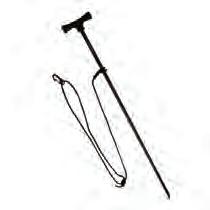






GEAR: I carry two rods, one for big fsh and one for smaller fsh, so I’ll be prepared for whatever I encounter. My lighter set-up is an 8-foot mediumaction rod with a spinning reel flled with 10- to 20-lb. braid attached to 12 inches of clear 30-lb. fuorocarbon leader.
For tarpon, big snook, sharks and big jacks, you need 40- to 60-lb. braid (200-300 yards) with a 60- to 80-lb. clear fuorocarbon leader. For big fsh, you need a heavier rod and 6000-8000 reel with a bigger spool for more line.
LURES: Tie your lures to your leaders with a loop knot. My favorite lures include 4-inch DOA paddletail (pearl white or silver sparkle) rigged on a 3/8oz. chartreuse jig head; a 1- or 2-oz. spoon (silver Krocodile or gold Johnson); topwater plugs (Skitterwalk, Zara Spook, or various chug plugs); and shallow running crankbaits. If it’s windy or rough, you might need to fsh heavier jigs or spoons.






BEST TIMES TO FISH: First light and an hour before dark are the best times to fsh. Te best tides are early incoming and early outgoing. Avoid slack tides. I also use moon phases, which regulate the amount of rise and fall during each tide.
FIND THE FISH: Find the bait, and you’ll fnd the fsh. Bird activity is the most obvious sign of bait in an area. Tis could be pelicans, gulls or even small terns nipping at baitfsh. You also need to be able to spot baitfsh. Identifying the little splashes or dark mass of a school is critical.
I walk the beach looking for bait. When I see bait, I stop and fsh. Birds aren’t always there, and the bait just pops up for a few seconds and you need to be ready. Go to a beach access, get out of the car and scan for birds. If you don’t see any birds, it might be worth going to another beach access, but remember that fnding bait is sometimes just a matter of moving down the beach a hundred yards.
TECHNIQUE: Identify the feeders. Bluefsh, jacks, mackerel, ladyfsh, kingfsh and barracuda are all aggressive feeders that like fashy lures and fast retrieves. If you’re fshing for tarpon, a slow steady retrieve is better. Snook will hit a slow retrieve and can also be caught in shallower water by jigging of the bottom around the frst cut. Whiting, pompano and croakers are all easily caught twitching a lure of the bottom, but you must get it out to them.
Richard L. Matteson is a long-time contributor to Coastal Angler Magazine who reports for the Stuart Rod and Reel Club. Contact him at (336) 414-3440.

The fight for an unforgettable catch begins here, where 100,000 square miles of deep blue waters play home to speedy blue marlin and wahoo, massive tuna and brawny mahi mahi. Deep sea fishing in The Out Islands is a battle of wits, a test of perseverance, and a chance to prove your angler’s instinct. See what could be waiting on the other side of your line.


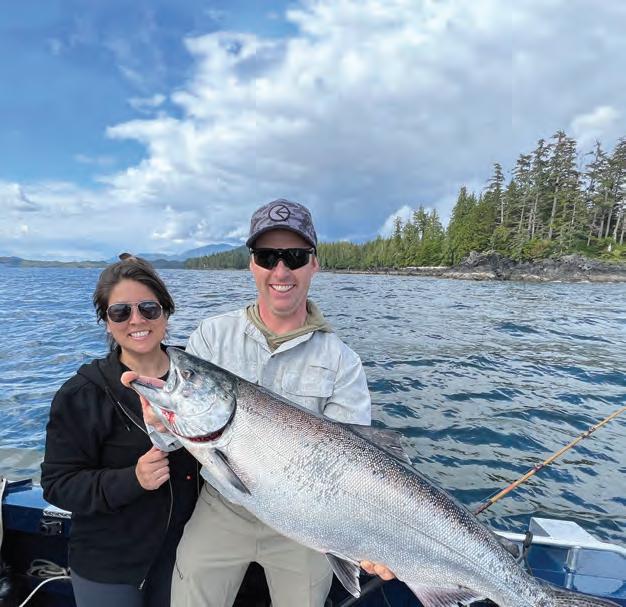
is true for human visitors, too. Te summertime fshing in Alaska can be astoundingly good.
Imagine awe-inspiring natural landscapes cascading into a sea teeming with marine life. I’ve lived and fshed in Fiji, Te Bahamas, Hawaii and Florida. Tey are all spectacular, but there’s nothing like an Alaskan summer.
My own journey to Alaska began as a young man when I dreamed of one day fshing there. Like most young adults, I strived to get good grades and work jobs to pay bills and tuition. I took the mainstream approach of university studies. Shortly afer graduation, I obtained a position with a fnancial frm. I loved the work; I hated the monotony of a nine-to-fve work life. Afer a year and a half, I called it quits and fed to Alaska with no contacts or the faintest idea of what it would be like. It’s now been 12 years, and I still call Alaska home for the summer fshing season.
I operate Ketchikan’s Finest Fishing Charters. My fshing partner, Jake Smith, and I consider ourselves lucky for the opportunity to provide topfight experiences for clients every day.
Te prime fshing season in Ketchikan is May through September, and we provide customized charters for any group, regardless of age or experience. You can expect to catch halibut, salmon, rockfsh, cod and even Dungeness crab. We ofer full-day and multi-day packages, with daily catches aggregating over hundreds of pounds. In addition, we ofer cruise ship charters for salmon and halibut to ft each visitor’s port times. With pick-up and drop-of from downtown ports, it’s the best way to fsh during an Alaskan cruise.
John Muir, the famous naturalist, wrote that you should never go to Alaska as a young man because you’ll never be satisfed with any other place as long as you live. From frst-hand experience, I believe this to be true.

Alaska still holds riches beyond one’s wildest dreams. Hundreds of millions of salmon food into their native streams and rivers to spawn each year. Giant barn-door halibut scour the deep seas. Humpback whales migrate thousands of miles to feast on Alaska’s annual summer bounty. Eagles, bears and other wildlife abound and celebrate summer, when it’s a feast for all. Tis
Imagine riding to the richest Alaskan fshing grounds with humpback whales breaching on the horizon. Eagles soar overhead and swoop to pluck salmon from the sea. Te fshing is insane, with massive halibut and lightsout salmon fshing. It’s sensory overload in a good way, and an experience that should be at the top of everyone’s bucket list.
If planning a fshing trip in Alaska seems daunting, know that modernday Alaska is accessible to all. Tere’s no need for foat planes or dog sleds. Ketchikan is a two-hour plain ride from Seattle in a commercial airliner that touches down in a modern airport. From there, everything is at your fngertips.
Check out Ketchikan’s Finest Fishing Charters at ketchikanfshingtrips.com. Contact them (907) 617-4717 or e-mail ketchikanfshingtrips@gmail.com.










Boating is unpredictable but with a BoatU.S. Unlimited Towing Membership, it’s easy to keep your cool if something goes wrong. With more than 600+ red boats on the water, TowBoatU.S. will have your back.
Anglers



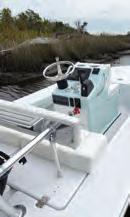









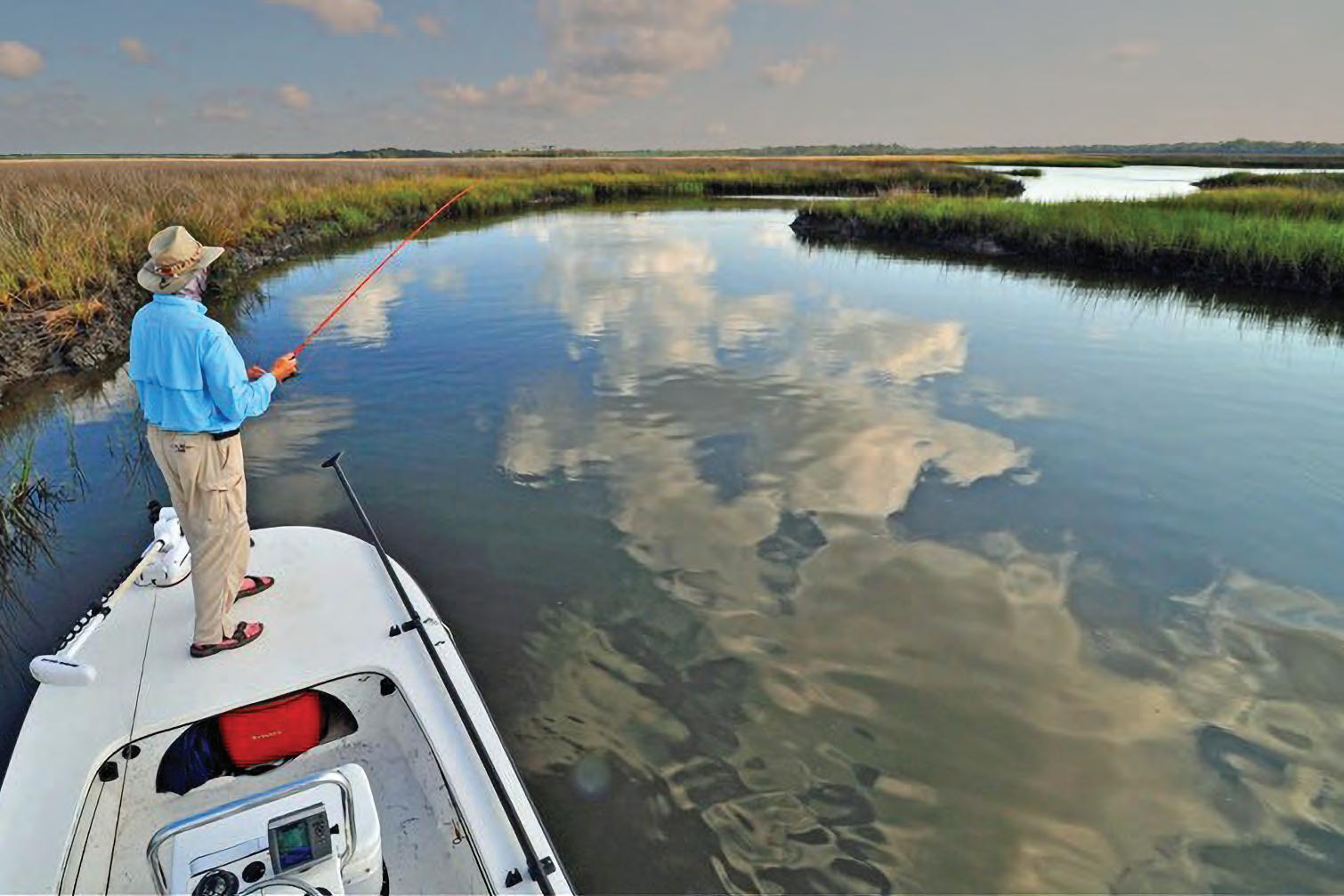
The year is 2024, and technology is getting better and better. Whether it be the retail tech business or the fshing industry, there are tools now available that a few years ago we would have never thought were even possible. One of those technologies is forward-facing sonar (FFS). Tere’s a lot of debate about FFS in the fshing these days, but there’s no denying it’s an amazing tool when used correctly.
I have been using this technology since its earliest stages, and catching fsh while looking at my screens has become one of my favorite ways to fsh. It is extremely cool to watch a fsh eat your lure in real time, and it can also teach you a tremendous amount about what is happening under the water. Not only do I use this tech to fnd and catch fsh, I use it to pinpoint bait and areas with life, fnd sweet spots and diferentiations in an area, and eliminate dead water much faster ever before.
Figuring out how to use this new technology can be a little frustrating at frst if you don’t quite understand what’s going on. Spending time on the water, doing as much research as possible or getting someone experienced to teach you are the best ways to get an upper

hand. Fishing lakes where catching fsh isn’t very hard in general helped
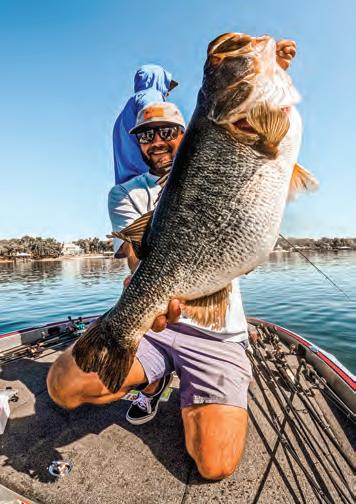
me tremendously with deciphering what I saw using FFS. Smallmouth fshing in the north country was a big helper, as these fsh are aggressive and you get many opportunities to present baits and dial in your skills.
Another thing that helps you understand the picture on your screen is objects that are visible above the water. Point your transducer at a bridge, dock, tree or grass, and picture in your head what should be under the water while also watching your screen. Tis will help beginners dial in settings and get a better understanding of what is displayed. It takes time, patience and dedication to learn, but don’t get frustrated and try to have fun with it.
Tere are varied opinions on forwardfacing sonar and its place in the fshing industry, but it isn’t going away, it will only get better! Some of the coolest things I’ve witnessed and some of my best fshing days were due to the electronics on my boat.
Spending the time to learn how to use FFS is well worth the efort. Te technology is dominating pretty much every tournament right now, and it absolutely revolutionized the way I break down a body of water.
Tere are many resources out there to help you in your learning process and people like me who are always willing to answer questions. Don’t be afraid to reach out, tight lines!
Tyler Woolcott is a professional tournament angler and guide. Check out his website at www.tylerwoolcottfshing.com.
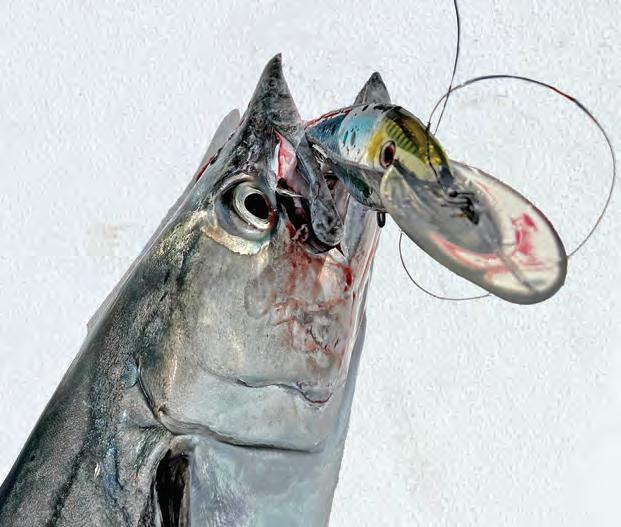
It’s well known that some of the best kingfsh fshing starts with a livewell full of frisky baits. Unfortunately, catching them can eat up much of your fshing time. Afer that, it can be hours of bump trolling waiting for a fsh to hit. Fortunately, for those who just want to head out for a couple hours of fun and blistering runs, it can be accomplished with artifcials. Besides getting you straight to the fshing, you can cover a lot more ground by pulling hardware, and it is not nearly as tedious.
Like using live bait, wire leader is crucial. Kingfsh have razor sharp teeth that will go through even stout mono with little efort. I prefer single-strand wire and usually opt for at least #7 (80-lb.). Single strand tends to kink afer just one fsh, but that’s not always a problem when pulling big plugs, as they will pull the wire straight. Also, watch your split rings. Tey can weaken the loop where it attaches to the lure, so be sure to constantly inspect your connections. I like to cover many diferent depths in the water column when trolling. I

start with a shallow runner like the Nomad 190 AT that runs 3 to 5 feet deep, which I set way back. I also like the Nomad Madmacs that run just slightly deeper. I run it 30 to 50 feet in front of my shallow long-bait to facilitate turning. Ten I like to go deeper with a DTX Minnow 165. I run that close to the boat and right under the prop wash. Tis is hands down my most productive bait. I fnd speeds of 6 to 8 knots usually work well. Tis allows me to cover a lot of ground and is fast enough to elicit a strike. I ofen fnd any slower and the fsh don’t seem interested. Te other great thing about these lures is the hooks are very large, and they stick once they make contact.
When you’re trolling the deeper-diving DTX 165s, you will need a reel with some signifcant drag, as these big-lipped plugs take a lot to hold in place. Te Accurate BV600, with its dual drag system, is a great reel for the job. Te BV X76H matches perfectly with it and is a great multi-duty trolling rig that doubles as an awesome grouper rod. Even though you don’t need a super-light tip, like with live bait, a rod that gives is a plus with these sof-mouthed fsh.
As for spots, look for hard bottom that holds bait. Wrecks and reefs are great, too. It sometimes pays to make wider circles around these structures to get away from the barracudas.
With a few lures and some know-how, you can easily head out and catch some kings without dedicating an entire day to your eforts.
Will Schmidt is a seasoned tournament anglers who has been writing about fshing for more than three decades.


























The heritage of American Silver Dollars is rich and diverse, marked by stunningly beautiful designs, leading to an enduring desirability in the hearts of collectors around the world. In this iconic U.S. Silver Dollar set, spanning nearly 150 years, you’re getting FIVE American Silver Dollars issued over the last 15 decades that each reflect the history, culture and economic aspects of the United States.
Each of these U.S. Silver Dollars is sought-after by collectors individually, but this set includes every design of U.S. Silver Dollar in American history, issued from 1878 to 2024!
Morgan Silver Dollar: First struck 146 years ago in 1878, the Morgan has a historic legacy as the coin that helped build the American West. Minted until 1904, then again in 1921, this 90% silver coin with its iconic Lady Liberty design is the most collected vintage Silver Dollar in the world. Extremely Fine (XF) condition coin included in set.
Peace Silver Dollar: With a beautiful design memorializing peace following the end of World War I, the 90% silver Peace Dollar was intended as a one-year only release struck in 1921—but it proved so popular with the American people, it was struck until 1928, then again in 1934-35. Extremely Fine (XF) condition coin included in set.
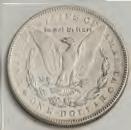

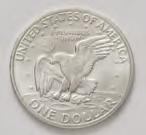





Eisenhower Dollar: The last circulating U.S. dollar coin, the Eisenhower Dollar, aka the “Ike Dollar,” was prized by Americans, with its design featuring war hero President Dwight D. Eisenhower, backed by an image symbolizing the Apollo II moon landing. First struck with silver 1971-1976, the Eisenhower Dollar in this set was struck in 40% silver for collectors, and you will receive a coin in Brilliant Uncirculated (BU) condition.



















Silver Eagle Type 1: The first-ever U.S. Silver Dollar minted in 99.9% silver, these coins were first minted in 1986 following President Ronald Reagan’s signing of the Liberty Coin Act into law on July 9, 1985, which authorized the U.S. Mint to strike America’s new silver bullion coin. This gorgeous Silver Dollar features the original, revered Type 1 “Heraldic Eagle” reverse design by John Mercanti, 12th Chief Engraver of the U.S. Mint. Brilliant Uncirculated (BU) condition coin included in set.
Silver Eagle Type 2: In honor of the popular 99.9% silver coin’s 35th anniversary in 2021, the Silver Eagle received a new, esteemed Type 2 “Eagle Landing” reverse design. This is the current issued coin by the U.S. Mint. Brilliant Uncirculated (BU) condition coin included in set.
SAVE with this Ultimate U.S. Silver Dollar Set! You’ll save both time and money on this 150 Year U.S. Silver Dollar Set, with FREE SHIPPING and a BONUS presentation case, plus a new and informative 150 Years U.S. Silver Dollars booklet! Call right now to get yours before they’re gone!












Ultimate U.S. Silver Dollars Set — Regular Price $249 - $199
Save $50.00 (over 20%) + FREE SHIPPING For fastest service call
